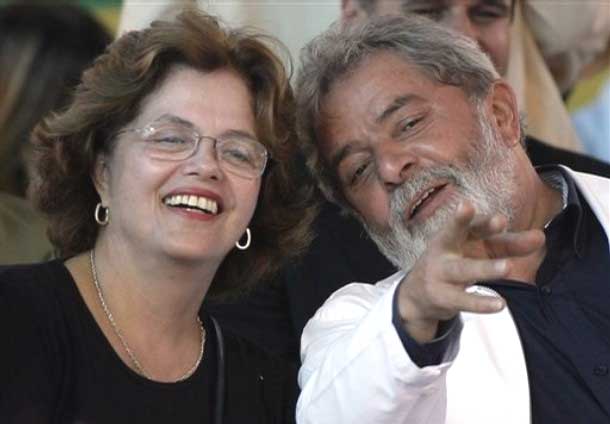
Can Lula translate his government's popularity to Dilma Roussef, his chosen candidate for president? Source: Google Images
After Lula, it looks like it’s the battle between Dull and Duller. Brazil’s presidential election in October is an important one, as the country’s success and new-found leadership role within the BRICs and G-20 make Latin America’s largest economy critical on the world stage. Lula has charisma, but his anointed successor from the PT party, Dilma Roussef, does not. Luckily for her, her rival, Jose Serra, who is ahead in the polls, is as dull or duller than she. That’s why he was trounced by Lula in 2002, for a time causing Brazilian bonds to trade at default spreads.
CSFB reports today (see below) that Serra remains ahead in opinion polls. Though slightly wider in March, Serra’s lead over Dilma has narrowed in recent months. The popularity of the Lula government (of which Dilma is a leading member) remains in the stratosphere, with 76% of those surveyed in March appraising the government as “excellent/good.” Yet only 45% of those saying so said they would vote for Dilma, which is not good enough for her to beat Serra, once mayor of the city of Sao Paulo and now governor of Sao Paulo State, Brazil’s most populous state and the one packing its economic punch. It’s too early to call this important election, but narrowing poll numbers this far out must worry the Serra campaign. A recent profile of the dour Social Democratic administrator can be found in this Economist article.
From today’s CSFB report:
Poll shows wider gap between voter intentions for José Serra and Dilma Rousseff in the presidential election. The Datafolha poll, published on 27 March, showed higher voter intentions in the presidential election for José Serra (PSDB), currently the governor of São Paulo, and a slight decline in intentions to vote for Dilma Rousseff (PT), the chief minister of the presidential staff, reverting part of her gain in February’s poll. Voter intentions for Dilma Rousseff declined from 28% to 27% from February to March, while voter intentions for José Serra rose from 32% to 36% (Exhibit 1).
Serra’s leading position in the simulations of the first round of voting in the presidential election rose from 4pps in February to 9pps in March. Voter intentions for federal deputy Ciro Gomes (PSB) went from 12% to 11% from February to March and remained stable at 8% for the former minister Marina Silva (PV). In the simulations for the second round, Serra obtained 48% of voter intentions versus 39% for Rousseff.
We believe that the wider gap between the voter intentions for Serra and for Rousseff represent a natural variation in opinion polls and does not point to any trend for the coming months. Since the February Datafolha poll, José Serra has suggested he would be the PSDB’s pre-candidate for president, which has bolstered his visibility among voters in recent weeks. Until the campaign starts in July, the scenario should continue to favor the government’s candidate, in light of the Lula administration’s high approval ratings. The March Datafolha poll showed that the administration’s “excellent/good” rating rose from 73% in February to 76% in March, the highest level in the time series (Exhibit 2).
An increase in voter intentions for Rousseff will depend on the government’s ability to transfer to its candidate the votes of those appraising the administration as “excellent/good.” In March, 45% of voters appraising the administration as “excellent/good” indicated they would vote for Rousseff in a possible second-round election dispute with Serra (Exhibit 3). Thus, a substantial increase in voter intentions for Rousseff would require an increase in this percentage.
Rise in median market forecast for IPCA inflation in 2010, from 5.10% to 5.16%.The Market Readout released yesterday (29 March) points to a rise in the median market forecast for IPCA inflation in 2010, for the tenth week in a row, this time from 5.1% to 5.16% (Exhibit 4). The higher expectations for IPCA inflation are explained mainly by the revisions in projections for short-term inflation, from 0.44% to 0.48% for the March IPCA index and from 0.39% to 0.40% for April. Conversely, after rising for two straight weeks, the median forecast for IPCA inflation in 2011 remained stable at 4.7%.
In our opinion, the upward revision in market expectations for IPCA inflation in 2010 was caused primarily by higher-than-expected consumer inflation in Q1 2010 and in April. While the median of expectations for cumulative inflation from May to December 2010 fell from 2.76% on 8 January to 2.69% on 26 March, expectations for cumulative inflation from January to April rose from 1.74% to 2.43% in the period. These results suggest that the majority of market participants merely incorporated the higher-than-expected inflation in Q1 2010 into their projections for 2010 inflation (Exhibit 5). We believe that the fact that the rise in inflation in the first few months of the year was mostly the result of higher prices of a seasonal nature (e.g., increase in tuitions) or a temporary nature (e.g., higher inflation in fresh food prices) means that the higher-than-expected inflation in the short term has not raised inflation expectations for longer horizons.
We do not expect market forecasts to increase significantly over the next few weeks. Our projections for IPCA inflation in March (0.45%) and April (0.40%) are near the median market forecast. Although the recurrently higher-than-expected inflation in recent months has increased uncertainty as to the dynamics of inflation in the short term, we think a reduction in consumer inflation is very probable in the coming weeks, especially because of the reversal of the price hikes that caused the higher inflation in Q1 2010.
Among the expectations for other economic indicators in 2010, we highlight the stability in the median forecast for the Selic basic rate at the end of 2010 at 11.25%, which assumes five consecutive 50bps increases in the Selic rate starting in April.